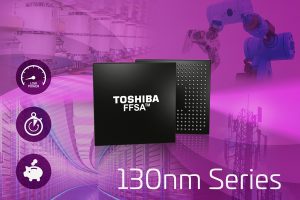It is estimated that 127 new internet of things (IoT) devices connect to the internet every second (McKinsey Global Institute). To stand out in a large and competitive market, manufacturers need a product that is innovative and unique. An application specific integrated circuit (asic) is designed to the manufacturer’s specific requirements. It provides optimum performance as well as providing high reliability, IP protection and a safe supply for the lifetime of the product.
A key component of any industrial IoT (IIoT) application is the sensor technology. The sensor’s role is to collect data that can later be analysed and used to improve efficiencies across many processes. The sensor requires an interface, which is where signal conversion of sensor data occurs, and where the analysis, control and transmission of it is handled. It is this interface functionality that can be differentiated through the use of an asic.
Customer requirements
Off-the-shelf IC components are designed and sold with maximum versatility in mind; systems built using standard parts are frequently over-engineered to achieve desired functionality. In contrast, an asic is designed specifically to a customer’s requirements to deliver an optimum performance.
When contemplating an asic, the design team first decides what the key drivers are in terms of performance, cost and size. These drivers will then flow down to enable the creation of an asic requirement specification that will more than likely be different to anything else that is available on the market.
Depending on the specific IC requirements, decisions are made on functionality, such as signal conversion rate, on chip microprocessor and memory type. The design team may choose to incorporate elements such as surge and reverse polarity protection to increase the chip robustness. The result of all these choices is a silicon device that is bespoke, optimised and exactly meets the requirements of the targeted application.
An experienced asic partner will be able to understand the system demands and recognise where the custom IC can unlock product potential by ensuring that the entire signal path is optimised to the finest detail.
Single package
When designing an asic chip, the developer integrates as much of the circuitry as possible into a single package. Reducing component count results in higher reliability, a reduction in PCB space and lower power consumption.
 As the silicon die is encapsulated within the packaging, it provides greater reliability due to a reduction in component count. Industrial sensors are often located in harsh environments and the robustness of asics in the system helps to maximise operational life.
As the silicon die is encapsulated within the packaging, it provides greater reliability due to a reduction in component count. Industrial sensors are often located in harsh environments and the robustness of asics in the system helps to maximise operational life.
A single silicon die provides a company with intellectual property (IP) protection, as an asic is extremely difficult to re-engineer or re-use in other designs. Some asic developer partners provide full ownership of the completed system design and do not sell standard chips on the open market. This allows manufacturers to be confident that the IP will remain for their benefit alone.
Non-obsolescence
Standard IC components will inevitably become obsolete when either the component supplier develops a new or upgraded part or if the sales volume or revenue drops below a certain level, making supplying the part no longer financially viable. This can cause issues even if the new part is an upgrade, as manufacturers will have to constantly redesign their system to accommodate new components.
In contrast, manufacturers can choose the asic route to ensure component supply for the lifetime of a product, with no gaps in availability. Asics are designed with non-obsolescence in mind, but if obsolescence of either the silicon process or the packaging does occur there are options available to the asic partner to ensure continued supply.
For packaging obsolescence, it is usually very easy to find an alternative source. If the silicon process becomes obsolete the customer can purchase a last time buy of wafers, which can be stored in dry nitrogen cupboards for up to 30 years. Alternatively, the asic supplier could port the design onto a new silicon process. The asic supplier will work closely with the customer to develop a non-obsolescence plan that eradicates the need for costly system redesign and requalification.
 Electronics Weekly Electronics Design & Components Tech News
Electronics Weekly Electronics Design & Components Tech News


